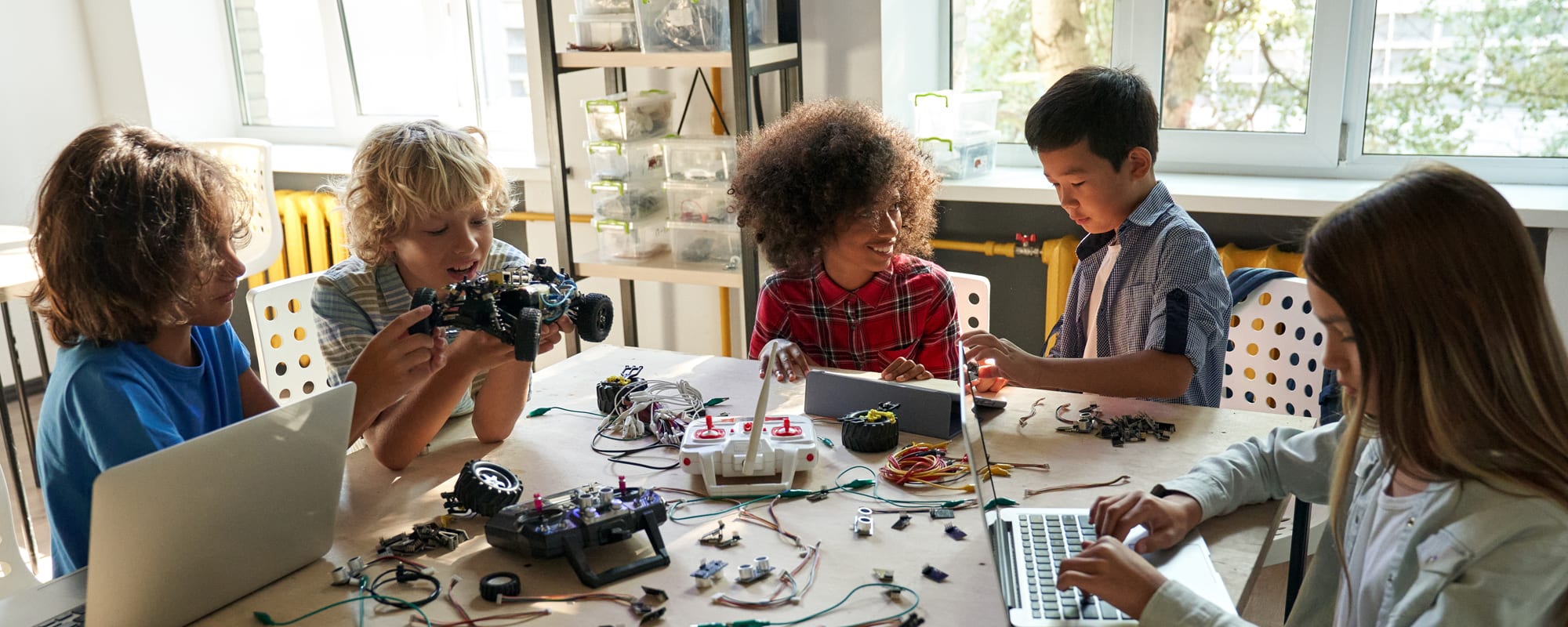The amazing world of STEM is growing daily. So, this National STEM Day, take some time to introduce your kids to one of these four game-changing new technologies that will shape our future. Getting kids excited about topics like AI, VR, robotics, and blockchain doesn’t have to be complicated. In fact, it can be fun for the whole family.
November 8th is National STEM Day, and that means taking a day to show our kids how to approach STEM topics with the same passion that we do — and maybe even planting the seeds for an exciting future in a STEM field like engineering.
Luckily, there has never been a better time to get excited about STEM. With new technologies changing the game and creating new fields of study all the time, there’s something sure to interest every child, no matter what their interests are. To help you start the conversation, we’ve rounded up four of the latest trends taking the STEM world by storm, as well as some useful tips about how to introduce kids to them in a way they’ll understand while also having some fun.
1. Artificial Intelligence
What Is It? Artificial intelligence (AI) isn’t a particularly new concept, but with vast enhancements in computing power, data storage, and algorithm development, the potential for AI has reached levels limited only by the imagination.
In many cases, the advancement of AI has forever changed how we view the relationship between humans and technology. Programs such as ChatGPT introduced the world to the idea of using AI to communicate ideas more effectively and efficiently, but this barely scratches the surface. Soon we will see widespread AI use in virtually every element of our daily lives, from transportation to the provision of healthcare and product design and manufacturing to entertainment.

Learning Ideas for Kids: You don’t have to go far to find a great way to show a child how fascinating AI can be. All you need is a computer. Experiments With Google is a great place to start. It offers a huge collection of resources designed to introduce kids of all ages to the idea of working with AI to create anything from stories to music. Teachable Machine, for example, is a fast and easy way to understand how to create machine learning models, while Quick Draw shows the power of AI by seeing if it can guess what you’re doodling.
Or you and your child could just have some fun putting prompts into ChatGPT. Want to generate a country song about how a cow and platypus became best friends? Type in the prompt and see what the AI comes up with.
2. Virtual Reality
What Is It? To a certain generation, the effect of virtual reality (VR) could be achieved with a View-Master and a few reels. We’ve come a long way since then.
Today, VR headsets are capable of generating fully interactive, 3D worlds that create an incredibly immersive experience. The first thing VR is likely to bring to mind is video games, but VR technology is now being adopted for a staggering number of applications. Medical schools are using VR to train doctors to perform complex surgeries; athletes are incorporating it into their training; architects are generating fully 3D buildings to explore before they’re built; automotive manufacturers are using it to measure the performance and safety of vehicle designs; and retail companies like Walmart are using VR simulations to train new employees.

Learning Ideas for Kids: If your kids like video games, there’s a chance that they already have more experience with VR than you do. But if they don’t, this can be a great way to spend National STEM Day — if you’re willing to do a little prep work and planning.
Especially for little ones, parental guidance is essential to introducing them to VR in a way that’s safe and productive. After investing in a suitable VR headset, like the Merge Headset, which was designed with kids in mind, develop a list of parameters such as where your child can use it (so they don’t trip or knock over anything) and time limits for playing. For example, the National Society for the Prevention of Cruelty to Children (NSPCC), which offers a number of VR safety tips for kids, recommends 10–15 minutes at a time, and a report from Common Sense Media co-authored by Stanford University’s Virtual Human Interaction Lab recommends 20 minutes with three-minute breaks between sessions. Next, decide how you’ll curate and supervise their VR experience to ensure that it remains age-appropriate.
When it’s time to play, websites like Google Expeditions, Tilt Brush, and National Geographic Explore VR have wonderful, kid-friendly VR experiences you can experience together. You can also find some great YouTube channels with VR videos that kids will love, like Discovery VR and 360 VR Kids. Due diligence is critical, but the rewards for both you and your child will be well worth it.
3. Robotics
What Is It? We all know what robots are. But today’s robots are being combined with recent advancements in AI and machine learning, and as a result, our children will soon be interacting with robots in ways we only saw at their age on “The Jetsons.”
The world already has fully robotic restaurants, prosthetics featuring “mind control” and touch sensations, and (taking The Jetsons’ housekeeper to a new level) cleaning robots capable of eradicating harmful viruses like Ebola with 99.9% effectiveness. By the time our kids are grown, some human jobs could be completely taken over by robots, while others will take advantage of the speed and efficiency robotics are capable of by integrating them into core job functions alongside workers. So, the sooner kids can get comfortable working on and with robots to solve problems, the better.

Learning Ideas for Kids: Parents have lots of options to introduce kids to robots and the systems that power them. DIY robotics kits like the LEGO Boost Creative Toolbox are great places to start. This kit not only introduces kids to how robots are physically constructed, down to the sensors, but also how to program them.
For kids who express an even greater interest and want to take their knowledge to the next level, there’s a wealth of after-school camps and programs available for all age levels. Some will be local and in-person, while others, like the classes from Skyfi Labs and MakerKids (both of which offer free trials) are available online. You could also introduce your child to one of the many available games designed to teach them basic coding techniques — a critical skill valuable in many careers in addition to robotics. Play along with them, and you might learn something new too.
4. Blockchain
What Is It? While cryptocurrency has been in the news a lot lately, the real story is in the blockchain technology that cryptocurrency is built on.
In simple terms, a blockchain is a decentralized public ledger capable of recording transactions through multiple computers working together to form a network. Whenever a transaction occurs on the ledger, it’s validated by every computer in the in network, chronologically recorded in a history of transactions, and then encrypted. This system makes it nearly impossible for anyone or anything to alter or steal the data on the chain. As such, it’s projected to become the single most important development for society since the Internet as it continues to mature. Healthcare, energy, finance, retail — there’s not a single field or industry that blockchain won’t change in a significant way given the security and transparency it provides.

Learning Ideas for Kids: As far as introducing kids to technology goes, blockchain is a bit of a doozy. Still, if you think your child might enjoy a challenge, understanding such an abstract concept early in life could prove to be a huge advantage. You might be surprised by what your child can comprehend.
Try not to get too complicated too fast. Start by talking to your child about one of the most important concepts they will ever learn: money. While blockchain has implications beyond financial transactions, its use in that sector is probably the best way to introduce the concept — and after all, accounting is a part of STEM, too. Teach them about why money is important, how you earn it, how you use it, and how you keep track of it. Have them sit with you as you check your online accounts and pay your bills, or maybe take them with you to the bank to make a deposit. It might not be the most exciting field trip ever, but lots of banks do offer free lollipops. Classic board games like The Game of Life, Pay Day, and Monopoly can also be a great springboard for financial discussions, and it’s hard to beat a good family board game night.
Once you’ve helped your child establish a baseline understanding of finances, it’s just a matter of gradually adding elements of blockchain to the discussion as the conversation moves from physical money to digital money and cryptocurrency. Several key points can be explained by comparing them to real-world counterparts. For example, cryptocurrency is a digital form of what you keep in piggy banks. Digital wallets have the same basic function as regular wallets. And blockchain is a way to keep people from taking your digital wallet or breaking your digital piggy bank.
Enjoy National STEM Day Together
National STEM Day is a wonderful opportunity to spend some quality time with your kids, introduce them to concepts and technologies that you enjoy, inspire them to think about the future, and explore exciting new horizons together. So, we hope you have a happy National STEM Day, enjoy seeing the wonders of today’s game-changing technologies reflected in your children’s eyes, and maybe even learn something new too.







